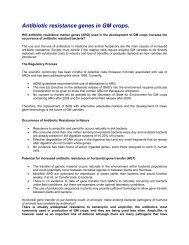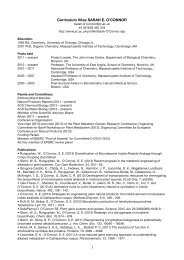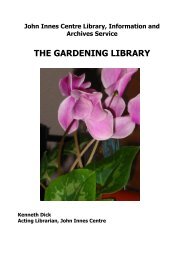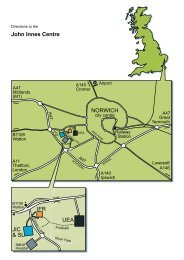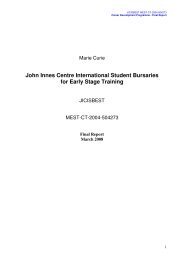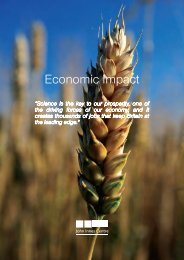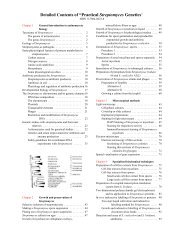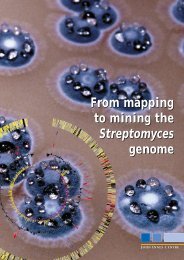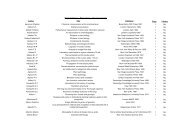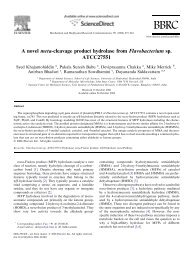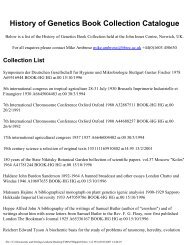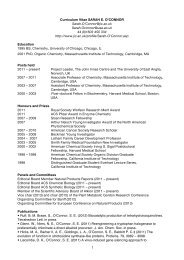1910s Timeline - John Innes Centre
1910s Timeline - John Innes Centre
1910s Timeline - John Innes Centre
You also want an ePaper? Increase the reach of your titles
YUMPU automatically turns print PDFs into web optimized ePapers that Google loves.
1928 C D Darlington completes<br />
important work on polyploidy<br />
and on Oenothera<br />
C D Darlington completes two<br />
important papers on polyploidy<br />
and Oenothera; these are<br />
published in Nature and the<br />
Journal of Genetics respectively.<br />
On polyploidy Darlington<br />
records that his very first idea<br />
came in December 1926 when<br />
he was travelling to work on the<br />
London underground with Alice<br />
Gairdner, one of Bateson’s<br />
assistants and with whom he<br />
collaborated on Campanula.<br />
They were discussing the effect<br />
of polyploidy on fertility,<br />
particularly on the tetraploid<br />
cultivar of Campanula percisifolia<br />
‘Telham Beauty’ and the hybrid<br />
Primula kewensis. He formulated<br />
what became known later as<br />
‘Darlington’s rule’: that there is a<br />
negative correlation between<br />
the fertility of the polyploid and<br />
that of the diploid from which it<br />
arose.<br />
This rule became the basis for<br />
the study of fertility in species,<br />
hybrids and diploids and<br />
polyploids until it was added to<br />
by Ralph Riley whose research<br />
on wheat identified specific<br />
genes affecting chromosome<br />
pairing.<br />
Darlington’s paper on the<br />
evening primrose Oenothera<br />
lamarckiana united this<br />
seemingly anomalous plant with<br />
Mendelism, the chromosome<br />
theory, and his own theories of<br />
meiosis.<br />
On Darlington’s research see<br />
also:<br />
C D Darlington, ‘Polyploids and<br />
polyploidy’, Nature, 124 (1929):<br />
62-64; 98-100<br />
C D Darlington, ‘Ring formation<br />
in Oenothera and other genera’,<br />
Journal of Genetics, 20 (1929):<br />
345-63.<br />
Dan Lewis, ‘Cyril Dean<br />
Darlington 1903-1981’,<br />
Biographical Memoirs of Fellows<br />
of the Royal Sociey, 29 (1983):<br />
113-157, esp. pp. 137-40.<br />
1928 Frederick Griffith’s<br />
experiments reveal a<br />
‘transforming principle’<br />
British medical officer and<br />
geneticist Frederick Griffith,<br />
working in the Ministry of<br />
Health’s labs on a vaccine<br />
against pneumonia infections<br />
following ‘Spanish flu’, shows<br />
that some component of heatkilled<br />
virulent bacteria can<br />
‘transform’ a non-virulent strain<br />
to become virulent. The<br />
unknown ‘component’ involved<br />
is later (1944) identified as DNA<br />
See: Biography and significance<br />
of Griffith’s work<br />
http://en.wikipedia.org/wiki/Fr<br />
ederick_Griffith<br />
1929 C D Darlington travels to<br />
Iraq, Iran and Russia<br />
In November 1928 C D<br />
Darlington is called to the<br />
Director’s office and told that he<br />
is not co-operating satisfactorily<br />
with other members of staff<br />
(probably C L Huskins). For this<br />
reason he is to be sent to Persia<br />
to collect tulips (and anything<br />
else of interest) at the joint<br />
expense of the Empire<br />
Marketing Board and the <strong>John</strong><br />
<strong>Innes</strong>, in the company (or<br />
custody) of an experienced<br />
botanist.<br />
In February 1929 Darlington<br />
embarks at Tilbury en route to<br />
Iraq and Persia to collect Prunus<br />
and Tulipa species with <strong>John</strong><br />
MacQueen Cowan, a retired<br />
Indian Forest Officer working for<br />
the Royal Botanic Gardens at<br />
Kew. Cowan’s goal was to<br />
collect 5000 specimens of plants<br />
in flower, to be dried and sent<br />
back to Kew labelled ‘Coll.<br />
Cowan and Darlington’. Though<br />
Page 14 of 91



